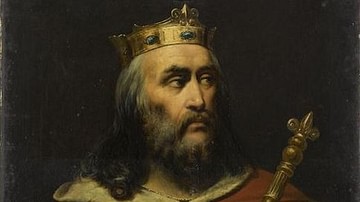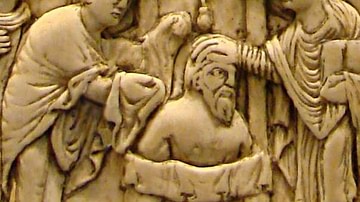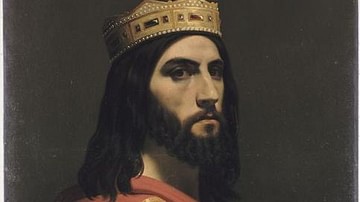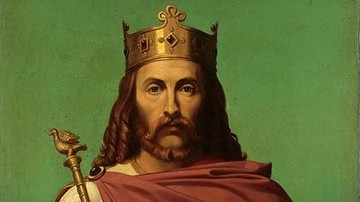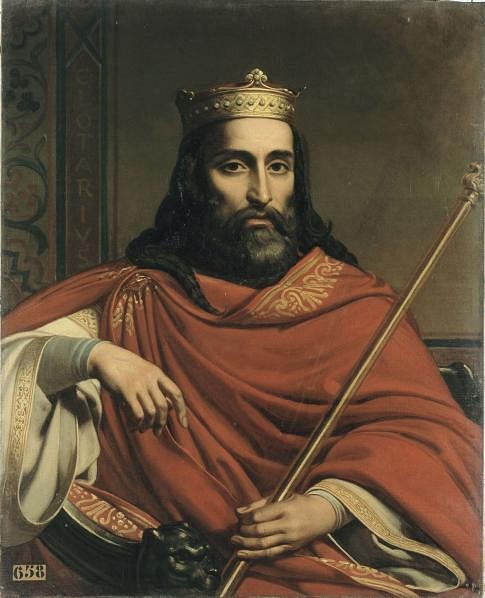
Chlothar I (l. c. 498-561) was a Merovingian king of the Franks, the second to rule over a unified Frankish kingdom after his father, Clovis I (l. c. 466-511). When Clovis died in 511, his kingdom was divided up between his four sons, but Chlothar reunified it by outliving his brothers and seizing their lands upon their deaths.
Chlothar (also given as Clotaire, Chlothachar, Hlothar, or Lothar) exemplified the ruthless ambition that would come to characterize the Merovingian Dynasty. He plotted against his own brothers, murdered two of his nephews, and executed his son in retribution for rebelling against him. He embarked on several military campaigns, at times fighting alongside his brothers, at other times against them, and helped to expand Frankish control to include the entirety of Gaul.
He had five concurrent wives, many of whom he married for political expediency, and he fathered seven sons. Chlothar managed to reunify all the Frankish lands under his sole rule in 558. However, the kingdom only remained unified for three years. When Chlothar died in late 561, the kingdom was once again divided between his four surviving sons. Thus, the cycle of violence and civil war in Merovingian France began anew.
Sons of Clovis
On 27 November 511 CE, King Clovis I died after an eventful reign of 30 years. Through a combination of conquest, cunning, and assassination, he had ruthlessly united the Frankish tribes and extended his kingdom to include most of Gaul and much of northern Germany. Upon his death, his realm was divided between his four sons: Theuderic, Chlodomer, Childebert, and Chlothar. Theuderic was Clovis' eldest son by an unknown concubine while the younger three sons, all minors upon their father's death, were the children of Clovis' wife, Queen Clotilde.
Traditionally, historians have viewed the partitioning of Clovis' kingdom as a simple adherence to Germanic inheritance customs. As opposed to primogeniture succession, where the eldest son inherits the entire estate, this Germanic custom ensured that each son received part of the inheritance. Clovis was, therefore, expected to divide his own estate in such a way by his Frankish subjects. As Susan Wise Bauer explains, the Franks would have resented any other method of inheritance and would have been outraged to have a single designated successor forced upon them, especially if such an heir was yet to prove himself in battle. The title 'King of All the Franks' must be earned, not inherited.
Another explanation for the partition is suggested by scholar Ian Wood, who argues that the idea had been implemented by Queen Clotilde herself. Under primogeniture succession, Theuderic would have inherited Clovis' entire kingdom, thereby leaving Clotilde's own children out in the cold. By persuading Clovis to adhere to the traditional custom, Clotilde guaranteed that each of her sons received a piece of the pie. In either case, this partitioning of the Frankish kingdom set a dangerous precedent for future successions, one that would ensure disunity, fragmentation, and war in the Merovingian kingdoms and lead to the eventual disintegration of the dynasty itself.
For now, however, the division created four distinct power bases in Gaul: Theuderic I (r. 511-534) ruled from Rheims, Chlodomer (r. 511-524) inherited Orléans, Childebert I (r. 511-558) ruled from Paris, and Chlothar I (r. 511-561), the youngest, was given Soissons. Chlothar's share of the territory included parts of Aquitaine and much of Belgium, the heartland of the Salian Franks, the tribe from which the Merovingians had originated. For the decade after Clovis' death, not much is recorded of his four sons, who were likely busy establishing themselves in their new kingdoms.
A Mother's Vengeance: The Burgundian Campaigns
In 523, Queen Clotilde called a meeting of her sons. "My dear children," she said, according to Gregory of Tours, "you must surely resent the wrong which has been done to me. You must do all in your power to avenge the death of my mother and father" (166). Clotilde was speaking of the murder of Chilperic II of Burgundy, her father, who was assassinated in 493 alongside his wife. Their bodies were thrown down a well and their killer, Chilperic's brother Gundobad, seized their lands for himself and drove Clotilde and her sister into exile. Now that her sons had grown and possessed armies, Clotilde charged them with invading Burgundy and seeking revenge. Her sons agreed and assembled their forces.
Gundobad had died in 516, and the rule of Burgundy was now divided between his feuding sons, Sigismund and Godomar. Clotilde's sons took advantage of this discord in launching their invasion and defeated a Burgundian army under Sigismund in 523. After the battle, Sigismund was captured along with his wife and children. They were brought before King Chlodomer who had them all executed, their bodies unceremoniously tossed down a well in a grisly attempt at poetic vengeance. The victorious Franks then ended the campaign for the season.
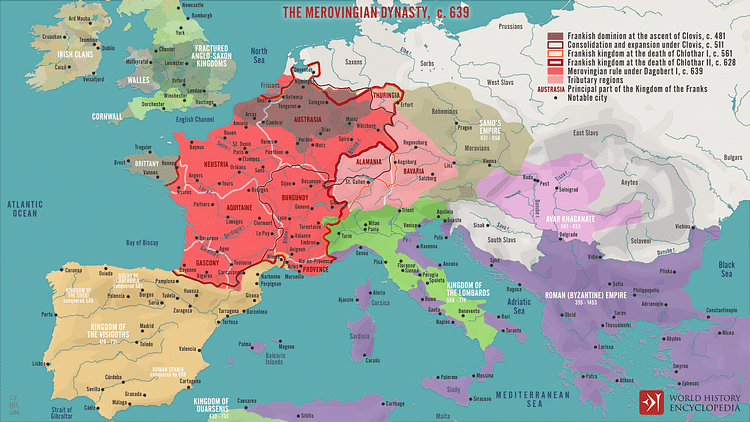
But although Sigismund was dead, Burgundy remained unconquered, and in 524, Clotilde's sons returned. This time, they were accompanied by their half-brother Theuderic, who had likely been persuaded to join by the prospect of loot. The Burgundians had been expecting them and had put together another army under the command of Godomar. On 25 June 524, the Franks and Burgundians clashed at the Battle of Vézeronce, which proved a devastating defeat for the overconfident Franks. Chlodomer himself was killed, his head hacked off and stuck on a pike. Although the defeat forced the Franks to withdraw from Burgundy, this was only a temporary setback.
In 532, Chlothar and Childebert combined forces for a third Burgundian campaign, vowing to avenge Chlodomer's death by hunting down and killing Godomar. The brothers laid siege to Autun and killed Godomar; however, by this point, their war of vengeance had become one of conquest. By 534, Burgundy was entirely occupied by the Franks. With its capture, the Frankish conquest of Gaul was complete. The territory was split between Chlothar and Childebert, with Chlothar receiving Grenoble, Die, and the surrounding lands.
Murder of Chlodomer's Sons
Immediately after Chlodomer's death in 524, the surviving three brothers raced to carve up his lands. Chlothar took Tours and Poitier for himself and went a step further by marrying Guntheuc, Chlodomer's widow; through this marriage, Chlothar gained access to Chlodomer's treasury. But there was a slight problem: Chlodomer had not died childless. He had left behind three young sons, Theodebald, Gunther, and Clodoald, who were still entitled to their father's lands. The boys were sent to Paris to be raised by their grandmother, Queen Clotilde, who doted on them.
Chlothar and Childebert felt that their positions were threatened by Chlodomer's children and plotted to get rid of them. In 532, shortly before the final Burgundian campaign, the brothers arrived in Paris, under the guise of planning their nephews' coronations. Clotilde was delighted, believing that the crowning of her grandsons would finally give her peace regarding Chlodomer's death. When Chlothar and Childebert sent for the children, Clotilde happily obliged. But as soon as the princes left Clotilde's protection, they were set upon by Chlothar's men; Theodebald and Gunther were captured, but Clodoald managed to escape.
Next, Chlothar and Childebert sent a man to Clotilde's residence, bearing a pair of scissors in one hand and an unsheathed sword in the other. According to Gregory of Tours, he delivered an ultimatum to the queen:
Your two sons, who are our masters, seek your decision, gracious Queen, as to what should be done with the princes. Do you wish to see them live with their hair cut short? Or would you prefer to see them killed? (181)
To cut the long hair of a Merovingian prince meant to deny all his claims to kingship and deprive him of his inheritance (hence the Merovingians' nickname as 'Long-Haired Kings'). In the heat of the moment, Clotilde replied that she would rather see her grandsons dead than see them deprived of their birthrights. The man took her reply back to Chlothar, who wasted no time in stabbing ten-year-old Theodebald through the armpit, killing him.

Upon witnessing his brother's murder, 7-year-old Gunther clung to the feet of Childebert, sobbing and asking for mercy. Childebert took pity on his nephew and asked Chlothar if they could spare his life. Chlothar became enraged, shouting, "Make him let go [of your feet], or I will kill you instead!" (Gregory, 181). Chlothar ripped the boy away from Childebert and killed him with a blow to the ribs. When the princes were dead, Chlothar and Childebert had their tutors and attendants slaughtered before riding out of Paris. Clodoald, the third son, managed to avoid his brothers' fates. When he heard of their murders, he cut his hair short, renounced all his claims, and went to live a monastic life.
Conquests & Civil Wars
Around 531, Chlothar's half-brother Theuderic invaded Thuringia to avenge an insult done to him by the Thuringian king Hermanafrid. Theuderic asked Chlothar to accompany him on this campaign, a proposition which Chlothar happily accepted. The brothers defeated Hermanafrid's army in a battle along the River Unstrut; here, writes Gregory of Tours, the Franks killed so many Thuringians that "the bed of the river was piled high with their corpses and the Franks crossed over them to the other side as if they were walking on a bridge" (168). Hermanafrid managed to escape, but the Franks quickly conquered his kingdom and took captive several of his relatives including his niece, Radegund.
Theuderic requested Hermanafrid join him at Zülpich to discuss terms and offered him safe conduct, but when the Thuringian king arrived, he was 'accidentally' killed when he fell off a wall; Gregory of Tours makes the sarcastic remark: "certain people…suggest that Theuderic may have had something to do with it" (169). Theuderic and Chlothar argued bitterly over who was entitled to Radegund. Chlothar won the argument and took Radegund back to Soissons, where he married her as his second wife.

Not long after, either in 533 or 534, Theuderic died, and his kingdom passed to his son, Theudebert I. Ever the opportunist, Chlothar immediately attempted to annex parts of Theuderic's kingdom, hoping to sideline Theudebert in the process. But unlike Chlodomer's sons, Theudebert was a grown man who had already been tested in battle and had gained the support of his father's vassals. Theudebert made an alliance with his uncle Childebert, and the pair marched against Chlothar, defeating him in battle. Chlothar was forced to take refuge, leading Theudebert and Childebert to try and siege him into submission, but a violent storm destroyed their siege equipment, forcing them to break off the siege and make peace with Chlothar.
In 537, the Ostrogoths ceded the territory of Provence to the Franks to ensure their neutrality in an ongoing war between the Ostrogoths and the Byzantine Empire. The three Frankish kings divided the rule of Provence between them. In 542, Chlothar joined with Childebert to campaign against the Visigoths in Spain, taking Pamplona and Zaragoza before the Franks were defeated and forced to abandon their conquests.
In 548, King Theudebert died, leaving the Kingdom of Rheims to his son and heir, Theudebald I. Theudebald reigned for seven years before dying in 555 without children. Chlothar seized on the opportunity, marching into Metz and marrying Theudebald's widow, Vuldetrade, to help legitimize his claim. This marriage was protested by Chlothar's bishops, who condemned it as unholy and incestuous, and Chlothar was forced to divorce Vuldetrade. He split Theudebald's kingdom with Childebert; the four kingdoms of Clovis' sons had become two.
Wives & Children
Like his brothers, Chlothar was a Nicene (Catholic) Christian because of their father Clovis' conversion, but under Salic Law, Frankish nobles were allowed to take multiple wives at once for political alliances and to ensure enough sons for succession. Chlothar's wives, and the sons born to them, include:
- Guntheuc: married in 524, widow of Chlothar's brother Chlodomer. She had no children with Chlothar.
- Radegund: married in 532, taken as a spoil after the conquest of Thuringia. Radegund was known for her piety and was later canonized. She had no children.
- Ingund: Chlothar's third wife, who had five sons and two daughters, including Gunther and Childeric (who predeceased Chlothar), Charibert I of Paris (d. 567), Guntram of Orléans (l. c. 532-592), Sigebert I of Austrasia (l. c. 535-575), and Clothsind, queen consort of the Lombards (d. c. 568).
- Aregund: Chlothar's fourth wife, and the sister of his third wife Ingund. Aregund bore one son, Chilperic I of Neustria (l. c. 539-584).
- Chunsine: Chlothar's fifth wife who gave birth to Chramn (d. 560), Chlothar's most troublesome son.
- Vuldetrade: widow of Chlothar's great-nephew. Chlothar was forced to divorce her by his bishops.
Chlothar was also known to have multiple mistresses and fathered several illegitimate children throughout Gaul.
Rebellion of Chramn
Queen Clotilde died in 544. Chlothar and Childebert had her buried beside Clovis in the Church of the Holy Apostles in Paris. Her death reignited the spark of rivalry between the brothers, who continued to look for ways to undermine one another. In 555, while Chlothar was off campaigning against the Saxons along the Weser and Elbe rivers, Childebert saw his chance to strike. He allied himself with Chlothar's ambitious son, Chramn (also given as Chram or Chramm), and together the pair plotted Chlothar's downfall.
Gregory of Tours describes Chramn as a cruel and dissolute man, who was "extremely ill-advised in nearly everything he did" (207). Chramn had been sent by his father to oversee the administration of lands that had previously belonged to Theudebald. Taking his seat at Clermont-Ferrand, Chramn earned the hatred of the townsfolk by doing whatever he pleased, consistently breaking the law and insulting the local count. At the goading of his uncle Childebert, Chramn extended his influence over nearby territories and began acting as an autonomous ruler independent from his father.
Still occupied by his war with the Saxons, Chlothar sent his sons Charibert and Guntram to end Chramn's insolent rebellion. The brothers marched to Limoges, where they found Chramn awaiting them with an army of his own. As the two sides prepared for battle, Chramn sent a messenger to his brothers informing them that Chlothar had been killed in battle against the Saxons. This was a lie, but it was enough to make Charibert and Guntram turn around and march their army to Burgundy, so they would not be left out of the succession plans. By time they figured out they had been fooled, Chramn had captured Chalon-sur-Saône through siege and had solidified his power by marrying the daughter of the count of Orléans. Meanwhile, Childebert used the rumor of Chlothar's death as a pretext to invade his kingdom, pushing as far as Rheims and pillaging the land around the city.
For a while, the dual threat of Childebert's invasion and Chramn's rebellion threatened to destroy everything that Chlothar had spent his whole life building. But then, on 23 December 558, Childebert died after a long and violent illness. Childebert had no children, allowing Chlothar to lay claim to his lands. Chlothar marched his army to Paris, which submitted to his rule, and seized Childebert's treasury and lands. Forty-seven years after Clovis I's death, the Frankish Kingdom was united once again, this time beneath Chlothar's banner.
After absorbing Childebert's kingdom, Chlothar met with Chramn under a truce, but the two could not come to an agreement. Realizing he could not defeat his father in battle, Chramn took his wife and daughters and fled to Brittany, where he was welcomed into the court of Chanao, count of the Bretons. In 559, Chramn led the Bretons in raids on his father's territories, laying waste to many villages. This left Chlothar with no choice but to retaliate. In November 560, Chlothar and his son Chilperic led a Frankish force against a Breton army led by Chramn and Count Chanao. After a large and bloody battle, the Bretons were defeated, Chanao was killed, and Chramn fled.
Chramn made his way toward the coast, where ships were waiting to take him away. Gregory of Tours notes that he lost time gathering his wife and daughters, allowing Chlothar's men time to catch up and capture him, around December 560. Chramn was immediately sentenced to death; he was bound and placed in a poor man's hut, along with his wife and children. Chramn was strangled before the hut was set ablaze, and his wife and daughters burned alive.
Death & Succession
Gregory suggests that Chlothar was wracked with guilt by the method with which he had killed Chramn. He apparently visited St. Martin's Church in Tours, bringing with him many gifts in the hope of repenting of the many evil deeds he had done throughout his 50-year reign. In 561, while on a hunting trip in the forest of Cuise, King Chlothar I came down with a fever and died; Gregory asserts that he died on the first anniversary of Chramn's execution. His surviving sons had his body returned to Soissons, where he was buried with great fanfare.
With Chlothar's death, the Frankish kingdom was again divided into fourths, having only been reunited for less than three years. Charibert I inherited Paris, Guntram took Orléans, Chilperic inherited Soissons, and Sigibert was given Rheims. With this new generation of Merovingian kings came another round of civil wars, assassinations, and suffering for the people of Frankish Gaul. This constant and bitter infighting, exemplified during Chlothar's own reign and during the reigns of his sons, would eventually help lead to the end of the Merovingian Dynasty itself.






